
The GST Accrual method combines the total value of sales, purchases and PAYG transactions completed in a selected period, and reports them according to the tax codes used.
 |
Before commencing the first GST Session in Jim2, the GST reporting basis must be configured in Tools > Options > Accounts to GST Calc Method – Accrual. To ensure transactions are included in the relevant GST Period, before commencing a GST session ensure that bank account and credit card account reconciliations are up to date. |
1.To begin a GST Session, go to Accounts > GST Sessions on the ribbon.
2.The GST session opens at Current GST on the Sales tab, displaying all transactions that have not been included in a previously reconciled GST Session. Transactions coloured black fall within the selected date range of the GST session. Transactions coloured red fall outside the selected date range (either before or after the date range).
|
If a GST session has been completed, selecting Current GST before the end of that period may present a blank screen. This will change once the next day after the Date To date has been reached, or dates entered are after the closed GST session. |
In the example below the BAS Period has been set for the period 1/10/2018 – 31/12/2018.
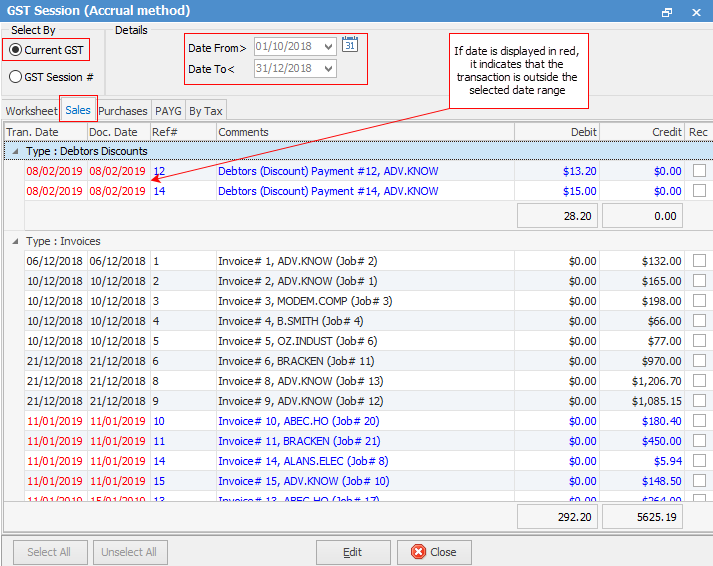
 |
When using GST sessions, the default GST Period set in Tools > Options > Accounts will default the current GST reporting dates to the next expected GST session. The default dates can be overridden so, to report GST quarterly and PAYG monthly, the GST Period default can match one or the other, and the session/report date range can be changed as required. |
3.To commence a GST session, click Edit. Select the transactions. To make the selection process as easy as possible, the options are either:
▪select all types of transactions (sales, purchases, and PAYG) found for the specified period by clicking Select All Types at the bottom left of any tab, or
▪select all sales, purchases and PAYG transactions found, that need to be reported for the selected date range, by either selecting the individual tabs and choosing Select Sales only (or Purchases, etc.), or choosing Select All at the bottom left.

4.The GST Session will now display all transactions that have been highlighted with a green background, and there will now be a tick in the Rec column at the right of the screen. Note that any transactions dated before the selected date range are automatically included, however transactions dated after the selected date range are not.
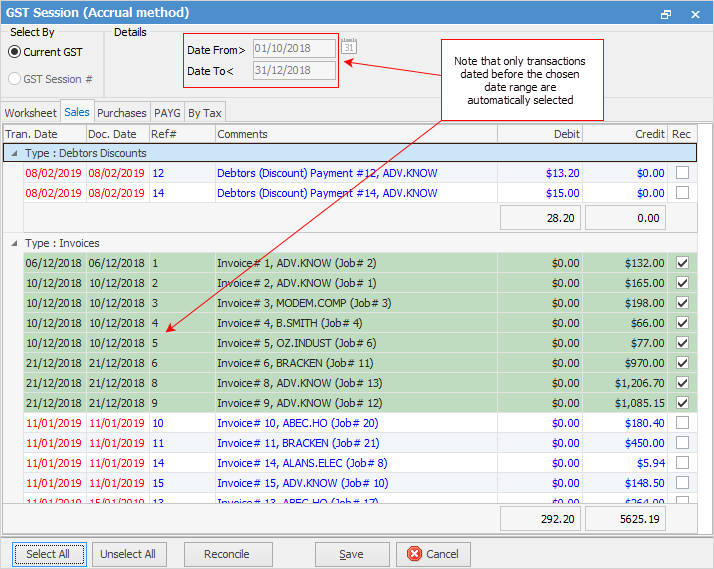
 |
Exclude specific sales, purchases or PAYG transactions by unticking the Rec checkbox at the right of the transaction. Unticked transactions will not be included in the worksheet calculations, and will move to the next GST Session. Unselect All is also an option. |

5.Once all transactions have been selected to be included in the GST session, click Save to review the final figures on the worksheet and the By Tax tab before reconciling the GST session. The confirm message will appear reminding that saving will not reconcile the GST session – this is important as the GST session must be reconciled once the BAS is lodged. Once a session is saved, the selected transactions will recalculate the totals in the Worksheet calculation sheet, and should be checked prior to reconciling.
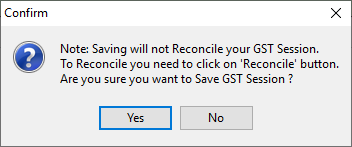
The GST session can be saved and returned to at a later time, or it can be reconciled.
6.Once a GST session is saved, users can check the worksheet calculations. Go to the Worksheet tab and tick Show partly reconciled only, so that only the selected transactions will be included in the totals.
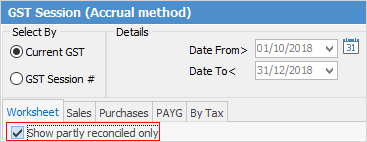
7.Check that there are no figures showing in incorrect areas. For example, if no goods are exported there should be no values in G2 Export Sales. If figures are showing in incorrect areas, review which transactions are reporting into these fields, and the tax codes used on these transactions using the By Tax tab. From there, drill down to the individual transactions to review and/or amend them.
 |
Note: Any changes are not automatically up in the saved session. You need to edit the GST Session, click Unselect All and choose All Types, then Select All, All Types (to pick up any changes, then Save and review again.
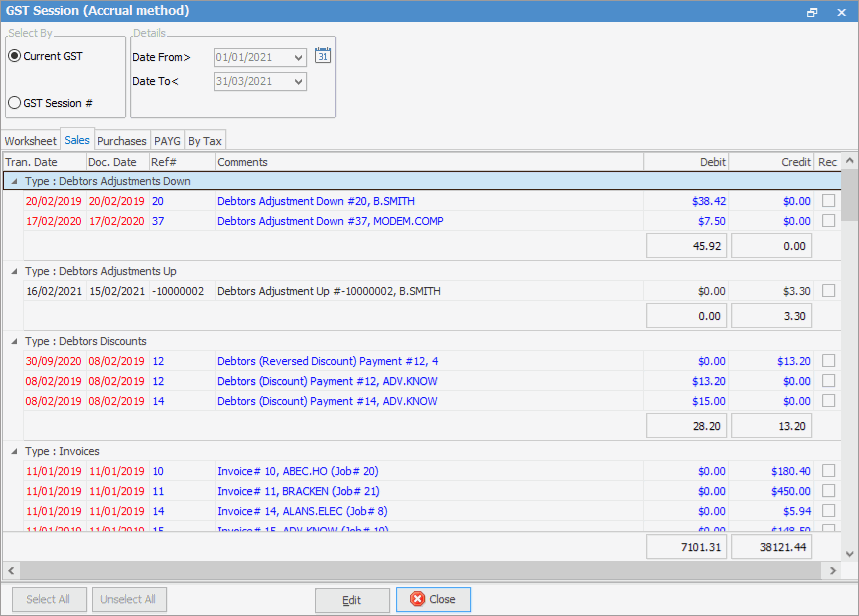 |
8.Once satisfied with the accuracy of the calculation sheet, click Edit, then Reconcile.
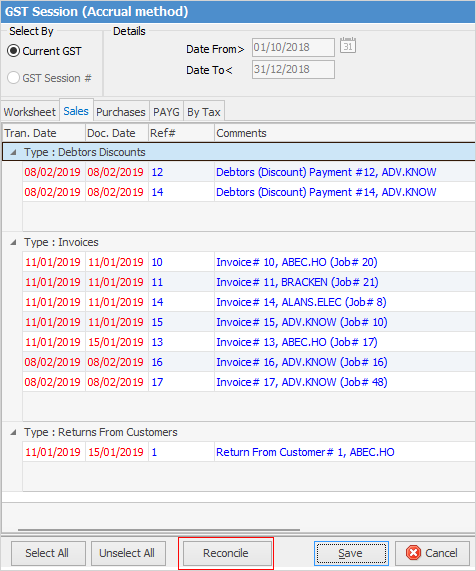
9.A confirm message will appear. Click Yes.
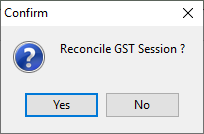
10.The reconciled GST session will be saved and allocated a GST Session number by selecting GST Session #. The session can be viewed at any time, and the relevant reports printed.
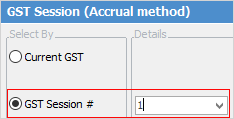
11.Either the GST Calculation Worksheet report or the GST Summary report can be printed, which is then used to complete the BAS. The information in both reports is identical, however the layout is slightly different.
12.Within the grid of the By Tax tab, right click and select Export Data. Save the detailed transaction information as a spreadsheet file, which can be printed or emailed to the company's accountant.
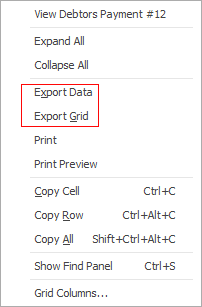
The detailed transaction information in a report can be printed by right clicking and selecting Print Preview then Fit to Page width. This report shows all transactions that are included in the GST session grouped according to the field they report into on the Worksheet. Use the Page Setup and Format icons in the report editor to change the page orientation, print order, enter a title for the report and page numbering as required.

 |
To view a previous GST session, change Select By to GST Session# and choose a session from the dropdown list. When viewing a previous session, that session can be deleted using the Delete Session button. This will return all those transactions back to Current GST to start over.
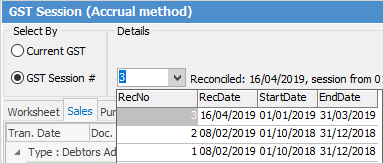
A GST session can be deleted if something is incorrect, however it is strongly advised not to delete a GST session once the BAS has been lodged. Any changes can be included in the next GST session.
The detailed reports found on the Sales and Purchases tabs list the transactions from each tab that have been included in the GST session, and do not report in a manner that directly corresponds to the fields on the worksheet. Refer to point 12 above for instructions on printing detailed reports. |
|
The GST reports found under Management Reports pre-date the introduction of GST Sessions, and were designed for the accrual method only. All transactions are automatically used to calculate liability, and do not reconcile transactions. These legacy GST reports have been renamed as GST [reportname] (old). Happen advises to use GST Sessions to calculate GST liability and produce reports, and not these reports. |
How to
Change GST Reporting from Cash to Accrual
Complete a GST Session: Cash Method
Handle NZ GST in Aust Database
Record Deferred GST on Imports